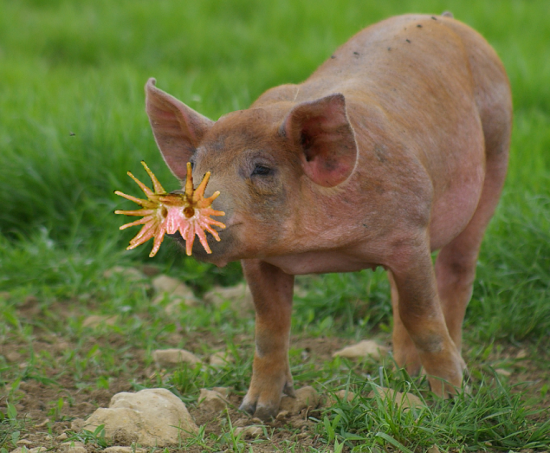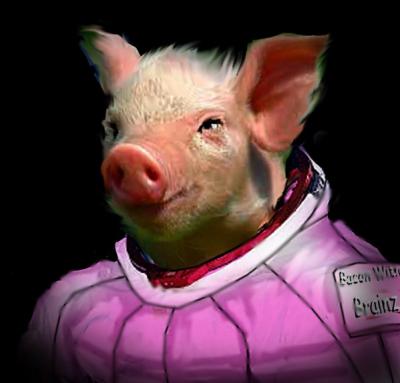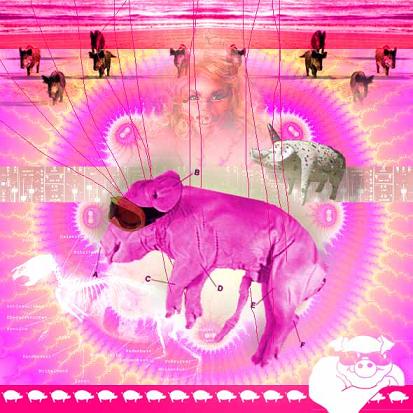BY LETTER
Neo-Pigs
Important and influential porcine provolve species |
 Image from Kirran Lochhead Strang |
In the first century AT it was discovered that pigs, even domesticated ones, were very intelligent animals, in some respects more intelligent even than chimpanzees. However, as they were largely considered to be nothing more than food animals, little interest was paid to this discovery.
Later, in the first century AT some genetic engineering was carried out on pigs, modifying certain types to be biologically compatible with humans, allowing the transplanting of pig organs into humans (xenotransplantation).
Further genetic engineering of pigs was carried out in the late first and early second centuries AT for various reasons, often to do with increasing meat production. The most radical of these modifications was by French truffle farmers, seeking to make a better truffle-hunter. They engineered their pigs with a vastly enhanced sense of smell, taste and touch, housed in a multi-tentacled nose, rather like that of a star-nosed mole, giving a vastly enhanced ability to rummage for truffles and other food. These changes were made at the cost of some visual acuity, but also included some brain enhancements to allow the pigs handle the new sensory inputs.
When chimps and dogs were provolved, some people suggested that the same might be done to pigs. The only problem with this idea were the many objections raised by people who wondered how sentient versions of food animals would consider those who both made them sentient, and who used to farm them for their meat.
Pigs were provolved in 350 AT, at least according to records kept by the pigs themselves. Many records were lost or distorted during and after the Technocalypse period, but it is possible the pigs' claims are correct.
Unlike provolved Chimps and Dolphins, the NeoPigs were not created by a public body of some kind, but instead by the Onion Hunters, a group apparently inspired by the Cult of the Exsanguinated Giraffe and using information gained from the Feynman Expert System to perform sophisticated bioengineering pranks. Their NeoPigs (as they came to be known) were based on the already-modified truffle-hunter pigs as their genetic code was already mapped in detail from the previous modifications made to them.
In many ways pigs were easier to provolve than dolphins, as there was greater mental similarity between pigs and humans than dolphins and humans. Likewise, fewer physical changes were required, giving the NeoPigs primate-based linguistic mental structures, including some empathy genes to allow them to work better in large groups (normal wild pigs living in small family groups of one male and several females) and modifying their voice-boxes to enable them to speak. Other changes included restoring the pigs eyesight (requiring some additional brain enhancement over their intelligence gain) and modifying their nose-tentacles to give them effectively a multitude of small manipulative trunks in two clusters, one on each side of the snout, rather like a prehensile moustache, while retaining their enhanced senses of smell, taste and touch. Their eyes were also modified to allow them to focus close to themselves without losing distance vision, and their ears made somewhat smaller and more erect (rather like those of wild boar) so as not to obstruct their eyes.
Although it is assumed that the Onion Hunters created some of the NeoPigs while they developed their genetic code, the first the world at large knew of them was when their genetic code was posted on the BioGeneticsDot datasphere site. And of course, some people grew some of them from the uploaded genetic data. Even now the identity of the Onion Hunters remains a mystery, although some evidence points to a Russian origin.
At first the NeoPigs were curiosities, and often simply pets, treated differently in different places depending on local attitudes and laws. They displayed a pragmatic and even-tempered outlook on life, with the ability to be very focused on things, but also adaptable, and with a well-developed sense of humour. As their numbers grew, the well-developed sense of smell of the NeoPigs found them work in environment maintenance, medicine, contraband control, police work and a number of similar fields. Their government roles were assisted by the fact that an adult NeoPig can be very large, quite as large as a normal pig, and just as strong.
When the existence of Neo-Pigs became known to the world at large, a number of groups, both established and newly-founded (often including individuals who had previously supported or at least condoned genetic engineering), reacted with horror and revulsion. While the precise wording of the rationales of these groups varied, the conclusion of history has largely been that the cause of the reaction was that the Neo-Pigs' creators had made food animals into sentient beings, and the objectors were displacing their own discomfort at this development onto the beings responsible for disrupting the status quo.
Two such groups, generally considered to be archetypal, were the Argentinian El Ganado No Son Personas, which meant, quite simply, "Livestock Aren't People," and the United States-based "Pearls Before Swine," a reference to a Christian holy text passage regarding the giving of objects of value to those who will not appreciate said objects. Both groups were responsible for several attacks in their home nations, often in collaboration with existing anti-provolution groups, who managed to increase their recruitment using the Neo-Pigs as a wedge issue.
However, despite attacks both physical and memetic, the new race managed to survive and thrive over the subsequent decades, eventually gaining full rights in multiple nations. This was partly due to the open source availability of their genetic code, and partly because anti-Neo-Pig sentiments were not actually widespread, despite the memetic efforts of their attackers. However, occasional resurgences throughout the remainder of the Solsys Era did occur, especially during times of economic distress.
The NeoPigs have never shown any great dislike for humanity despite their past oppression, and despite the best efforts of certain SapientChimp groups to encourage this. Instead they show a high degree of pragmatism. They learn from the past, and take precautions for the future, but do not let the past control them as they consider to be the case for many SapientChimps and Enhanced Dolphins. However, they often have pet humans.
NeoPigs were never specifically legislated for or against, but simply became an accepted part of sophont society.
In time they expanded out into space with humanity, SapientChimps and Enhanced Dolphins. However, their lack of hands rather limited their ability to operate in microgravity, causing their population to be concentrated in the habitats with spin gravity. As such they were badly affected by the coming of the nanite swarms, their population reduced to those NeoPigs living a small number of outer-system habitats.
With the post-technocalypse recovery, NeoPig populations increased, and the species began to grow and spread again, going out to the stars with the space rush of the First Federation, and settling a number of mixed and NeoPig-only colony worlds.
 Image from Steve Bowers |
Over the millennia there have been a number of Superbright NeoPig clades, and, usually arising from these, various NeoPig transcends. Some of these rule some of the NeoPig polities across Terragens space.
Some SuperBright NeoPigs, operating from a desire to help their non-provolved brethren have, over time, organised the provolving of a number of species with a close evolutionary relationship to pigs (similar to man with the great apes), including wild boar, warthogs, peccaries, and so on.
NeoPig habitats are often rather difficult for a more humanoid being to cope with. This mainly stems from their being built for horizontal rather than vertical creatures, and the use of scent markers rather than visual signals for many things.
In terms of personality, NeoPigs are pragmatic, even-tempered, focused, adaptable and have a good sense of humour. They are usually reasonably placid, too. However, they can become aggressive during the mating season, and females can in particular be aggressive when protecting their young.
In terms of appearance, 'baseline' NeoPigs are at first glance much like the non-sapient domestic variety. However, they have larger heads, and particularly large, almost human-like foreheads. Their ears are somewhat smaller, and the hips of female NeoPigs are rather larger than the non-sapient variety, to allow the birth of larger-headed young. The number of young born in a litter is also rather smaller than the unmodified pig, usually being around two, rather than six. Male NeoPigs often have large tusks, which they decorate in a variety of ways, often with carving or inlay. The most obvious difference from an unmodified pig are the two clusters of manipulative and sensing tentacles on each side of the snout, giving NeoPigs of both sexes what are effectively long prehensile moustaches. Male NeoPigs can grow up to two hundred kilos in weight, with females being smaller, up to roughly one hundred and fifty kilos. Some NeoPigs have modified themselves to have a much more wild boar-like appearance.
Most NeoPigs, being furless, usually wear clothes in inclement conditions.
NeoPig family groups tend to consist of one male and several females. In prosperous NeoPig groups females tend to have their own 'nesting rooms' where they go after the birth of their piglets. In other NeoPig groups there are community 'nesting hostels', or, indeed, the females simply eject the male while there are young piglets present.
Young adult NeoPigs are usually ejected from the family unit. As such most NeoPig communities have hostels for them to live in as they adjust and start to make their own way in life.
Appears in Topics
Development Notes
Text by Tony Jones with updates by bibliophile20
Initially published on 16 August 2003.
Initially published on 16 August 2003.







